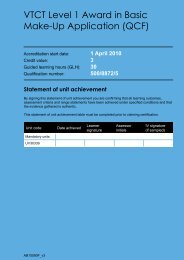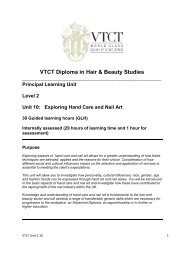Observations - VTCT
Observations - VTCT
Observations - VTCT
Create successful ePaper yourself
Turn your PDF publications into a flip-book with our unique Google optimized e-Paper software.
108<br />
Outcome 2: Be able to carry out massage using pre-blended<br />
aromatherapy oils (continued)<br />
Nervous system structure:<br />
Central nervous system (CNS) – brain,<br />
spinal cord, white matter, grey matter,<br />
meninges (pia mater, arachanoid mater,<br />
subarachanoid space, dura mater),<br />
cerebrospinal fluid, blood brain barrier,<br />
cerebrum, cerebellum, thalamus,<br />
hypothalamus, pituitary, pineal.<br />
Brain stem – midbrain, pons varoli,<br />
medulla oblongata.<br />
Peripheral nervous system (PNS) –<br />
spinal nerves (31 pairs), spinal nerve<br />
plexus (cervical, brachial, lumbar, sacral,<br />
coccygeal), cranial nerves (12 pairs).<br />
Autonomic nervous system (ANS) –<br />
sympathetic and parasympathetic divisions.<br />
Cells – neuroglia (schwann cells,<br />
oligodendrocytes, astrocytes, microglia),<br />
neurones (sensory, motor, interneuron,<br />
dendrite, cell body, axon, axon end<br />
terminals, neurotransmitters, myelin<br />
sheath, nodes of ranvier, neurolemma).<br />
Reflex arc, synapse, motor point.<br />
Nervous functions – sense internal/<br />
external stimuli, interpret and respond<br />
to stimuli, maintain homeostasis,<br />
programming, instinctual behaviour,<br />
assimilation, memory, learning, intelligence.<br />
Nervous disorders and diseases: Bells<br />
palsy, carpal tunnel syndrome, cerebral<br />
palsy, depression, epilepsy, meningitis,<br />
migraine, multiple sclerosis, neuritis,<br />
Parkinson’s disease, sciatica.<br />
Digestive system structure:<br />
Tract – alimentary canal (inner mucosa,<br />
submucosa, muscle layer, serous<br />
membrane), mouth, salivary glands,<br />
tongue, teeth, pharynx, oesophagus,<br />
UV30425<br />
stomach, small intestine (duodenum,<br />
jejunum, ileum), large intestine (caecum,<br />
ascending colon, transverse colon,<br />
descending colon, sigmoid colon, rectum,<br />
anus), liver, gall bladder, pancreas.<br />
Secretions – saliva, gastric juice, bile,<br />
pancreatic juice, intestinal juice, enzymes<br />
(salivary amylase, pepsin, trypsin,<br />
pancreatic amylase, pancreatic lipase,<br />
intestinal amylase, intestinal lipase,<br />
intestinal peptidases, maltase, sucrase,<br />
lactase), hormones (gastrin, CCK).<br />
Digestive functions: Ingestion, digestion<br />
(carbohydrates, proteins, fats, vitamins,<br />
minerals, fibre, water), absorption,<br />
assimilation, elimination, peristalsis.<br />
Examples of digestive disorders and<br />
diseases: Anorexia nervosa, appendicitis,<br />
bulimia nervosa, Crohn’s disease, cirrhosis,<br />
colorectal cancer, constipation, diarrhoea,<br />
diverticulitis, gall stones, haemorrhoids,<br />
heartburn, hepatitis, hernia, inflammatory<br />
bowel disease, irritable bowel syndrome,<br />
jaundice, ulcer.<br />
Urinary system structure: Kidneys<br />
(cortex, medulla, renal pyramids, calyx,<br />
nephron, hilus, renal artery, renal vein),<br />
ureters, bladder, urethra.<br />
Urinary functions: Blood filtration, urine<br />
formation, waste elimination, fluid balance<br />
regulation.<br />
Examples of urinary disorders and<br />
diseases: Urinary tract infections, cystitis,<br />
nephritis, kidney stones (renal canculi),<br />
renal colic.<br />
Endocrine system structure: Glands<br />
and hormones – hypothalamus, pituitary<br />
(oxytocin, vasopressin, growth hormone,<br />
adrenocorticotrophic hormone, luteinising
















